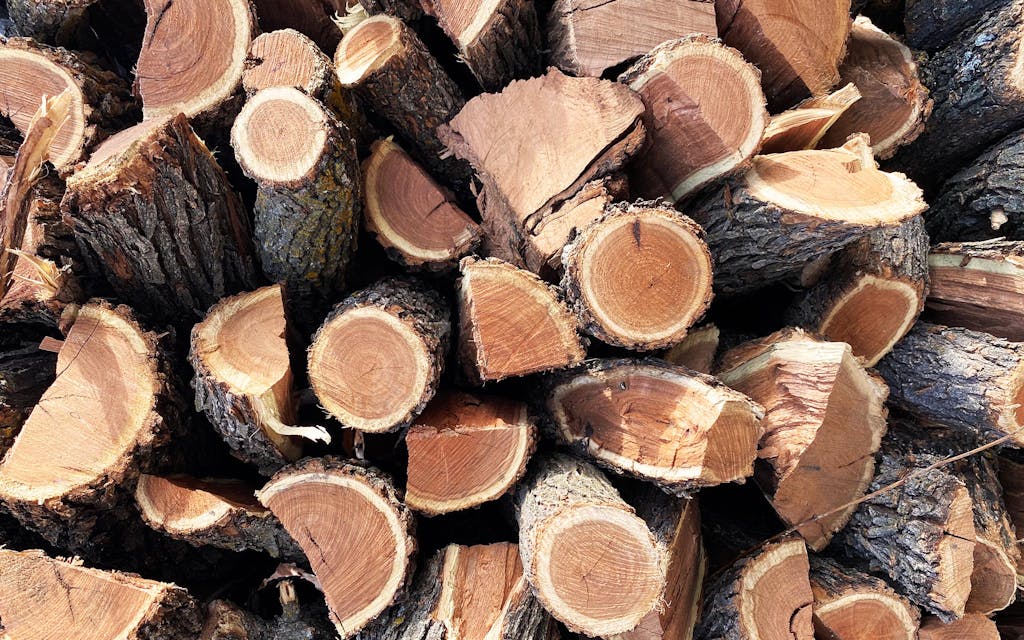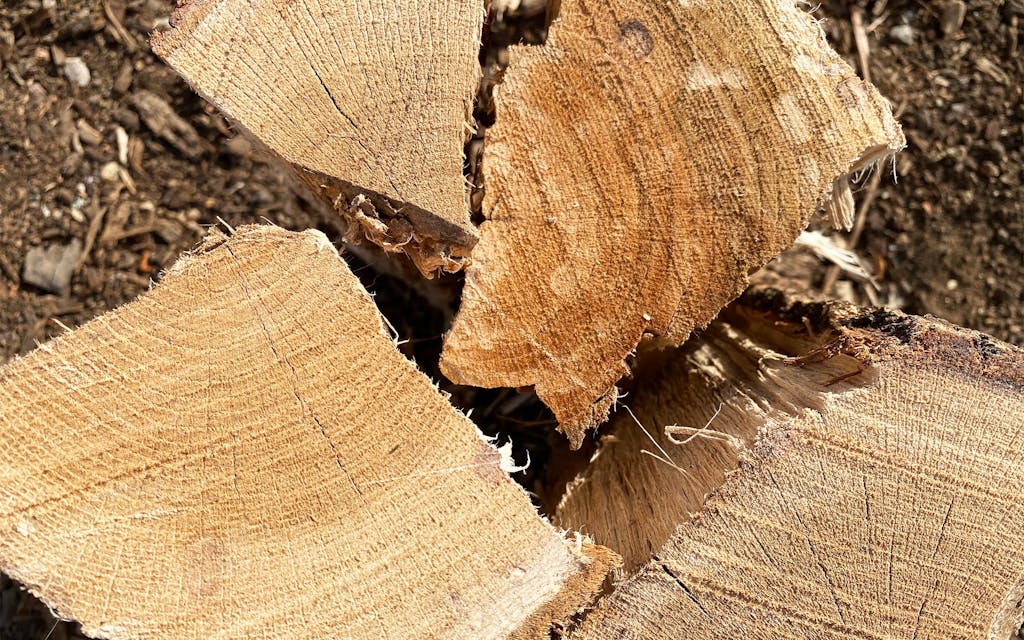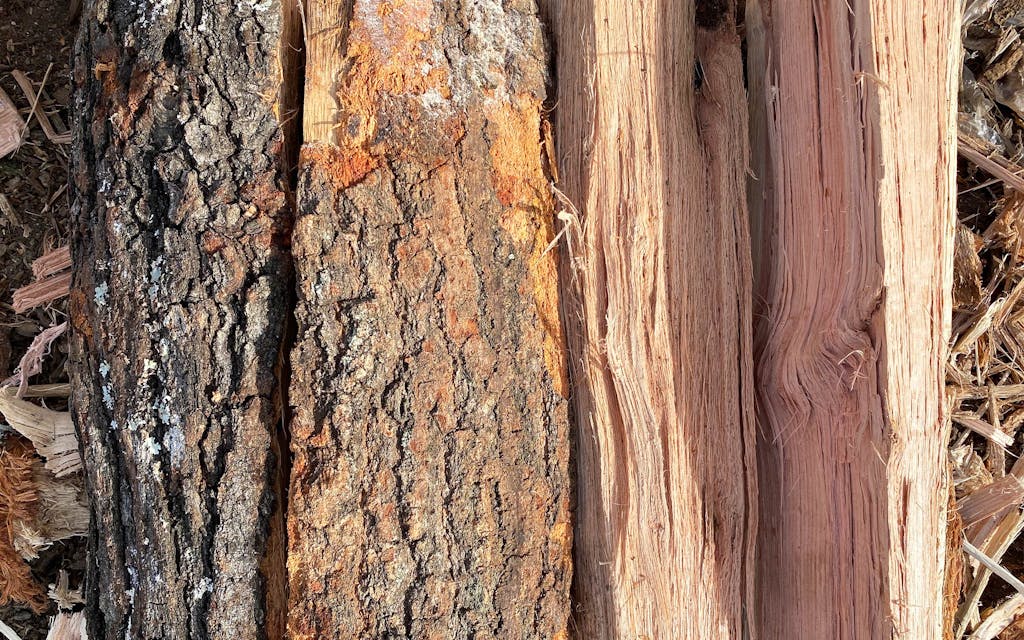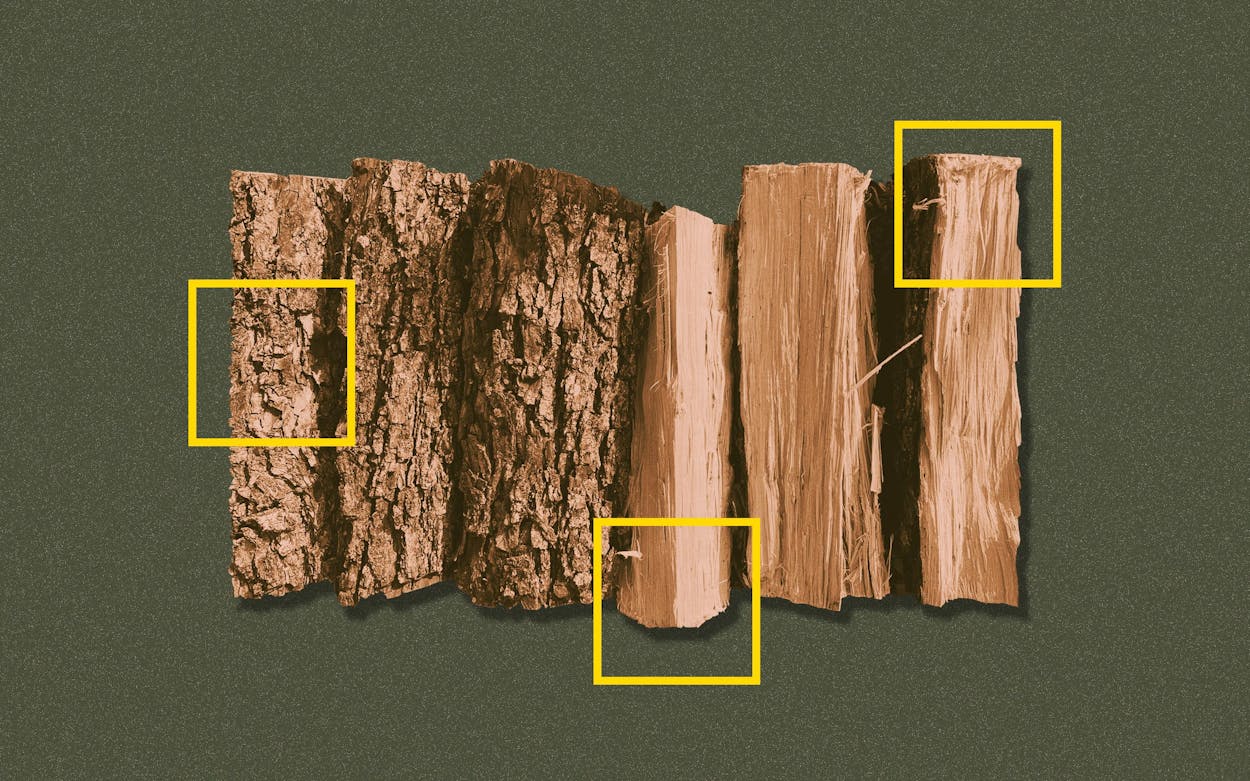The most basic thing you need to know about choosing the right wood for making barbecue is: don’t use pine (or, really, any other coniferous tree). Hardwoods are what you seek, but which ones? You might hear about alder, apple, peach, and beech wood on barbecue television shows, but in Texas we smoke with mesquite, oak, pecan, and hickory. I talked to several wood suppliers and pitmasters who made cases for their woods of choice. I also compiled tips to help folks at home more easily identify the different hardwoods they may come across.
The easiest way to identify a tree species is by its leaves, but that’s no help when the tree is already cut and stacked for firewood. The second is by the bark, which is often missing if the wood is kiln-dried rather than naturally seasoned outdoors after being split. I visited with Lennon Arnold, second-generation owner of Arnold Brothers Forest Products in Irving, to get some guidance. We walked the woodyard, and I snapped photos showing the grains and barks of the most popular varieties of wood for Texas barbecue. I also consulted the massively helpful book Texas Trees: A Friendly Guide, by Paul W. Cox and Patty Leslie, for a short description of each.
Pecan

From Texas Trees: “Pecan wood has a light reddish-brown sapwood and a darker heartwood,” with bark that is “thick, light brown to reddish brown, with narrow irregular fissures, flattened and scaly.”
Among commercial barbecue cooks, pecan seems to be the least popular hardwood, but it’s often mentioned among the favorites of backyard cooks. While the mild smoke flavor and the sweet smell are prized, one complaint about pecan is that it turns to ash pretty quickly without making robust wood coals. Kenneth Redwine of Redwine’s BBQ Eats & Sweets in Farmersville stopped using it when a few customers said they were allergic to pecan-wood smoke. There can be other drawbacks, too. “I always loved the pecan because it smelled so good,” says Trevor Sales of Brix Barbecue in Fort Worth. But it was more expensive and not as easily obtained as the post oak wood he uses. The wood is also fibrous and has little stray bits on the edges that catch fire easily, which can be a good thing—Nick Pencis of Stanley’s Famous Pit Bar-B-Que in Tyler says he likes to start fires with it.
Hickory

From Texas Trees: Hickory bark is “thick, silver to dark gray when young and almost black on older trees. Deeply furrowed with irregular fissures that form blocky ridges on mature trees.” The wood is “ideal for fuel because it has a nice flame, is virtually spark-less, burns a long time, and leaves a clean ash.”
Hickory is more popular in the northern parts of the state than anywhere else in Texas because it’s most plentiful there. Because hickory is the de facto wood used for bacon, the smell of any cut of pork smoked with this wood is reminiscent of it. “You get that traditional spicy flavor from the hickory,” Lennon Arnold explains. Greg Gatlin of Gatlin’s BBQ in Houston adds hickory into the smoker, along with post oak, for ribs and chicken because he likes the distinct aroma. At Smokey Joe’s BBQ in Dallas, Kris Manning uses hickory for ribs and chicken, as the previous generation did, but has switched to oak in the brisket pit.
Mesquite

From Texas Trees: The bark is “thin and reddish brown at first but eventually becoming grayish with deep fissures and thick ridges,” and “mesquite wood makes excellent fuel as it burns evenly with a hot flame and leaves behind good coals. For cooking, mesquite imparts a distinctive and delicious flavor rivaled only by hickory.”
“Mesquite has always had that traditional-barbecue taste to me,” Israel “Pody” Campos of Pody’s BBQ in Pecos says. “It’s a West Texas staple.” Though it has lost some ground to post oak, mesquite is still one of the most widely used barbecue woods, especially in South and West Texas where there aren’t many other local hardwood options. In a cross section, a thin, light band surrounds the deep red of the rest of the wood, making mesquite the most visually distinctive of the woods discussed here. It burns hot, and produces strong, acrid smoke if the fire is stifled, which gives mesquite a bad name for being too strong. Campos defends it: “If you’re burning clean mesquite, you’re going to get an amazing flavor.” He also says it creates a better smoke ring than other hardwoods he has used, like oak and pecan.
Oak
This is the point at which the hardwood discussion can become confusing, because there are so many types of oak. Post oak’s popularity has put it in high demand, but some wood suppliers may try to pass off white oak, live oak, and even red oak as post oak. Here’s how to tell the difference.
Post oak

From Texas Trees: The bark is “somewhat thin and gray-brown scaly at first, becoming thick and fairly distinctive, developing deep longitudinal fissures separating rounded, dark gray ridges.”
Kris Manning thinks post oak is “the best thing for building bark,” adding that “it puts good color on the meat without adding too much temp.” (He also cooks with hickory, which he says burns a lot hotter.) Daniel Brown of Brown’s Bar-B-Que in Austin likes the smoke from post oak for its “sweet taste.”
White oak

From Texas Trees: The bark is “gray and thin, somewhat scaly at first, becoming darker and furrowed with age.”
Michael Wheeler of wood supplier Sierrah Wood says because post oak and white oak are in the same family, “they have a pretty similar burn ratio,” so you can build and maintain a similar fire with either. He notes that if a supplier provided white oak instead of post oak, the main difference would be in the flavor of the smoke, with that of white oak being less distinctive than the vanilla flavors that come with post oak.
Red oak

From Texas Trees: The bark is “brown to gray with platelike scales, deeply fissured, sometimes smooth and gray.”
As the name suggests, this wood has a red tint to it. It’s denser than post oak, and will put off some very strong smoke if not well seasoned. Charles Brewer of Charlie’s Bar-B-Que in Beaumont uses a two-to-one ratio of red oak to hickory in his smokers. “I like that slow burn,” he says of the red oak, while noting that hickory burns hot and fast. He previously tried post oak, but didn’t like the flavor. “Maybe I like [red oak] because I was raised eating barbecue made with red oak,” he explains.
Live oak
From Texas Trees: The bark is “gray and smooth at first, becoming darker and furrowed with age.”
Like red oak, live oak is more dense than post oak and liable to put off strong smoke unless seasoned well. Dusty Miller of Miller’s Smokehouse in Belton swears by live oak wood because of its availability in the area—and because “it burns the same [as post oak], as long as it’s well seasoned.”








